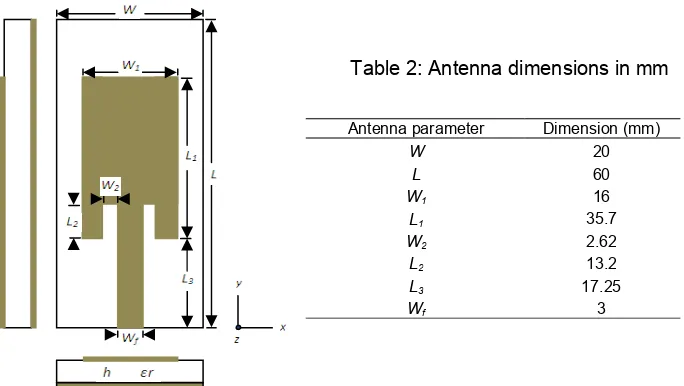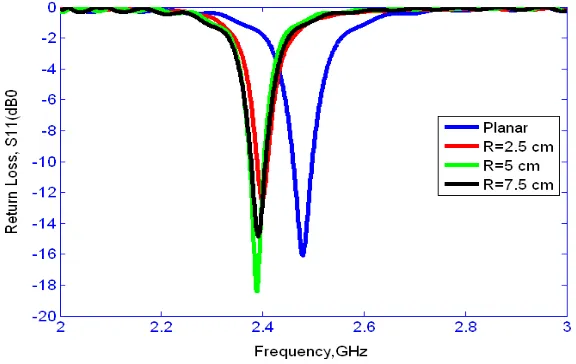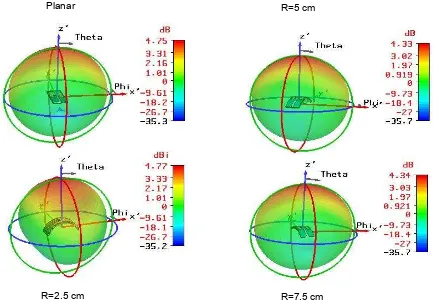accredited by DGHE (DIKTI), Decree No: 51/Dikti/Kep/2010 175
Wearable Conformal Antennas for 2.4 GHz Wireless
Body Area Networks
Emad Shehab Ahmed
Department of Electrical engineering, University of Technology Baghdad-Iraq
e-mail: [email protected]
Abstrak
Antena microstrip fed inset patch tertanam di permukaan planar dan kurva silindris diperkenalkan untuk digunakan dalam Body Area Networks (BAN). Antena ini dirancang sebagai wearable antena untuk jaringan nirkabel pada industrial, scientific and medical (ISM). Antena yang diusulkan terdiri dari baris microstrip 50 Ω feeding inset patch dicetak pada muka depan substrat dielektrik dan bagian persegi muka bawah. Antena planar diusulkan pada substrat silindris dengan jari-jari 2,5 cm, 5 cm, dan 7,5 cm yang masing-masing disesuaikan dengan ukuran pergelangan tangan manusia, humerus dan bahu tubuh manusia. Pemodelan dan evaluasi kinerja struktur silindris telah dilakukan dengan menggunakan perangkat lunak elektromagnetik CST Studio Suite 2009yang tersedia secara komersial. Hasil simulasi diperoleh rugi balik, distribusi arus, dan pola radiasi antena. Hasil menunjukkan bahwa antena konformal beresonansi pada frekuensi yang dirancang dengan karakteristik gain dan polamedan yang wajar.
Kata kunci: antena band ISM, antena patch inset, konformal antena, substrat silindris
Abstract
Microstrip fed inset patch antennas embedded in planar and cylindrically curved surfaces are introduced to be used in Body Area Networks (BANs) presented. These antennas are designed as wearable antennas for industrial, scientific and medical (ISM) band wireless communication networking. The proposed antennas consist of 50 Ω microstrip line feeding inset patch printed on the front face of dielectric substrate and a rectangular ground plane on the bottom face. The proposed planar antenna is conformed on finite cylindrical substrates of radii 2.5, 5 and 7.5 cm corresponding approximately to the typical size of human wrist, humerus and shoulder of a human body respectively. Modeling and performance evaluation of the cylindrical structures has been carried out using the commercially available electromagnetic software CST Studio Suite2009. Simulation results, obtained for the return losses, current distribution, and radiation pattern of the antennas are presented. Furthermore, results show that the designed conformal antennas are resonating at the designed frequency with reasonable gain and field pattern characteristics.
Keywords: inset patch antenna, conformal antenna, ISM band antenna, cylindrical substrate
1. Introduction
In Wireless Personal Area Network (WPAN) applications, there are essentially two channels of interest: off-body and on-body channels. The off-body channel is concerned with communication between a device on the body and a remote location. Example applications include short-range communications between two soldiers on the battle field or the transmission of medical data from a wireless sensor Body Area Network (BAN) to a remote station. On-body channels exist where there is a need for communication between devices located on, or within, the user’s body [1]. There is currently much interest in body-worn communication systems. Such systems are of interest for detecting motion on the body during exercise, monitoring functions such as heart rate and blood pressure, use by emergency services, and for general network connection [2].
Regardless of the application area, an important aspect of wearable communications is the preservation of antenna performance. It’s recommended to consider the following issues related to the design of such an antenna. The antenna itself must be small and lightweight, since it is part of a lightweight device. The small size of the antenna must not reduce its performance. The antenna structure must be designed to have limited radiation power in the direction of the wearer, to minimize possible health problems. The transmission power must be low, to prolong battery life and hence operating time [1, 4].
There have been ever growing demands for antenna designs that poss the following highly desirable attributes: compact size, low profile, low-cost and ease of fabrication. A microstrip antenna has been considered a promising candidate in wearable conformal structures due to some advantages such as being low profile, compact, and conformal [5, 6].
People, who serve the public such as police officers, fire fighters, and the like, require portable mobile communication devices in order to perform their job. Although the existing portable radio technology is smaller and more convenient than in the past, it suffers from several drawbacks. For example, as duty shifts increase, battery power must be increased to enable lasting communication devises. Portable radio components distribute their weights on a user’s body and utilize the user’s body as a vehicle for carrying a radio [7].
The development of wearable computer systems has been growing rapidly. System level modeling of possible low power and low cost radio transceivers to be employed within the wearable system, creating the body-centric WLAN. In a possible wearable computer, the monitor/display, the keyboard, and the motherboard are all integrated on the body. It is undesirable to use bulky cables to connect these devices, so communication will be wireless, using an antenna.
Current candidate technologies for BANs in the field of wireless short-range connectivity include IEEE 802 family of wireless personal area networks (WPANs) and wireless local area networks (WLANs), Bluetooth, and ZigBee. IEEE 802.15.6 WLAN technology is of high complexity, large form factor, and power hungry. The WPAN technology IEEE 802.15.1 (Bluetooth) and IEEE 802.15.4 are much better suited for battery-powered BANs. Bluetooth exhibit less flexible networking features, limited usability for uninterrupted real-time data transfers, and higher average power consumption [8]. On the other hand, ZigBee builds on top of the IEEE 802.15.4 MAC and PHY standard providing 250 Kbits/s at 2.4 GHz. The 2.4 GHz PHY seems appropriate for BANs given its data rate and worldwide spectrum availability [9].
The antenna performance under bending conditions is one of the important factors for wearable applications. This paper investigates the analysis of the radiation, and the impedance characteristics of an inset patch antenna embedded in planar and cylindrically curved surfaces. The impact of curvature on the performance of an inset patch antenna is modeled and simulated. Modeling and simulation of the planar and non-planar conformal inset-fed patch antenna is carried out through commercially available electromagnetic software CST Microwave Studio TM 2009. Results on return loss and radiation pattern are reported for the planar and non-planar conformal antenna.
2. Proposed Antenna Structures and Design
A planar microstrip fed inset patch antenna is proposed as the reference antenna. The resonance frequency fmn of a planar, rectangular patch antenna can be determined by the width W and length L of the patch and the substrate thickness h and permittivity eff of the dielectric [10]. The dimensions of the patch can be roughly determined by
where c is the speed of light (3x108 m/s) in free space, eff is the effective relative permittivity of
Equation (1) can be modified to include variations in the effective length by assuming the new length lies along an arc midway through the dielectric material. Ignoring changes to the fringing fields, the new length can be written as
2
2 1
1
h L h L
Leff
(2)
and Leff becomes L1 in (1) and is zero. Then the reference planar antenna is bended to get a structure conformed to the cylindrical surfaces with different radius of curvature represents wrist, humerus, and shoulder.
2.1. Planar Inset Fed Microstrip Patch Antenna Design
Figure1 shows the geometry of the proposed printed inset patch antenna. The antenna is printed on a dielectric substrate with a relative permittivity of 3.38 and a thickness of 1.254 mm. The antenna consists of an inset patch and a 50 ohm microstrip feed line on the top side of the substrate, and a ground plane of 1mm thickness on its bottom side. CST Microwave Studio
TM
2009 is used to optimize the antenna dimensions. The optimization procedures aims to adjust the desired resonant frequency while maintaining the antenna input impedance around 50 Ω value near 2.5 GHz. The optimized parameters of the antenna shown in Figure.1 are summarized in Table.1. The simulated return loss for the antenna is given in Figure 2.
Antenna parameter Dimension (mm)
W 20
L 60
W1 16
L1 35.7
W2 2.62
L2 13.2
L3 17.25
Wf 3
Table 2: Antenna dimensions in mm
Figure 2. Return loss of planar t h
2.2. Wearable Non-planar Conformal Antenna Structure
The proposed wearable antennas are designed to be worn on the exterior body and outer garments or tactical vests operating at 2.4GHz ISM wireless networking band. Four positions have been chosen to predict the performance of the proposed wearable antenna structures. These positions are wrist, humerus, shoulder, and safety helmet.
According to the proposed positions, three different cylinders with radius R=2.5, 5, and 7.5 cm were chosen, corresponding approximately to the typical size of human wrist, humerus and shoulder or helmet respectively. The proposed planar antenna is conformed to the selected cylindrical structures. Figures of these structures taken from the simulation software are shown in Figure 3.
3. Simulation Results and Discussion
The non-planar microstrip fed inset patch antenna conformed to various base radii are modeled, and their performance is analyzed for return loss less than -10dB. The return loss obtained for the defined radius of curvature is plotted in Figure 4. The resonant frequencies of the cylindrical conformal structures are 2.4, 2.3998 and 2.3917 GHz, the -10dB bandwidth is of about 40MHz. It can be clearly seen that the resonant frequencies of the conformal structures are small drifted from the designed frequency of planar model, and this must be kept in mind when choosing the operating frequency of the conformed antenna.
Figure 3. Planar and cylindrically curved structures taken from software. Structures of radii 2.5cm, 5cm and 7.5
Planar
R=2.5 cm
R=7.5 cm R=5cm
The distribution of surface current flows at resonance frequencies for all structures under consideration are shown in Figure 5. Figure 5 shows the vector surface current at resonant frequency of each antenna. It can be seen that the patches exhibit the same current distribution and hence almost the same radiation characteristics.
Figure 5. Surface current distribution for different structures
Planar R=2.5 cm
R=5 cm R=7.5 cm
Figure 6. Far field 3D patterns for the planar and conformal structures R=2.5 cm
Planar R=5 cm
The simulation of radiation characteristics for the proposed antennas at their operating frequencies within the impedance bandwidth obtained has also been studied. Figure 6 shows the 3D patterns of the proposed antennas.
The proposed conformal antennas display almost the same radiation characteristics of the planar structure antenna. It is observed that the radiation patterns are Quisi-ominidirectional and similar to the conventional monopole antenna. The antennas show appropriate gain characteristics defined between 4.33 to 4.77 dBi suitable for wireless communication.
4. Conclusion
In this paper, inset-fed microstip conformal antennas have been introduced, in an attempt to present wearable antennas with Quisi-omnidirectional radiation. The design and performance of wearable microstrip inset fed patch antenna for 2.4 GHz ISM band have been demonstrated. The antenna conformed on cylindrical substrates represented virtual locations on wrist, humerus and shoulder of the human body. These locations assumed to be the most natural and comfortable locations to wear the antenna. The designed antenna shows good characteristics with wearable requirement that is simple in shape, having a small size, being largely unaffected by the presence of conformal structures and providing reasonable gain with omni directional radiation patterns.
References
[1] Conway G.A., Scanlon W.G, Linton D. Low-Profile Microstrip Patch Antenna for Over-Body Surface Communication at 2.45 GHz, available at: www.4taconic.com/dielctrc/pdf/technicalarticles--patch [2] Zhu S, Langley R. Dual-Band Wearable Textile Antenna on an EBG Substrate. IEEE Trans. Ant. And
Prop. 2009; 57(4): 926-935.
[3] Winterhatler C.A. Development of Electronic Textiles to Support Networks, Communications and Medical Applications in Future U.S Military Prospective Clothing Systems. IEEE Trans. Information Technology in Biomedicine. 2005; 9(1):402-406.
[4] Hao Y, Aloit A. Body-Centric Wireless Communications. Dept. of Electronic Engineering, Queen Mary, University of London, available at: http://www.elec.qmul .ac.uk/antennas/index.html
[5] Tanaka M, Jang J. Wearable Microstrip Antenna. Proc. IEEE, AP-s. 2003; 2: 704-707.
[6] Saonen P, Keskilammi M, Sydanheimo L. A low Cost 2.45 GHz Photonic Band-Gap Patch Antenna for Wearable Systems. Proceeding of 11th IEE International Conference on Antennas and Propagation. 2001; 2: 719-723.
[7] Kese S, Yoon J. Body Conformal Portable Radio and Method of Constructing the Same. United State Patent, 5884198 (Patent). 1999.
[8] http://www.ieee802.org/15/pub/TG6.html.
[9] ZigBee Specification v1.0, ZigBee Document 053473r00, Version 1.00, ZigBee Alliance dated December 14, 2004.
[10] Kumar G, Ray K.P. Broadband Microstrip Antenna. Boston, Ma: Artech House. 2003.


